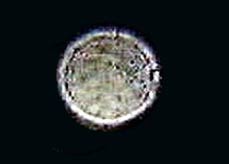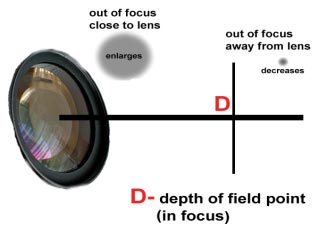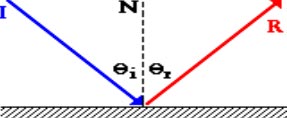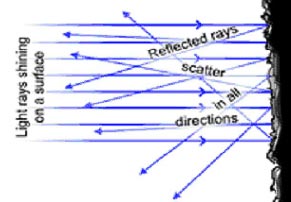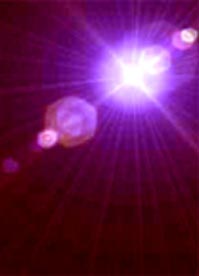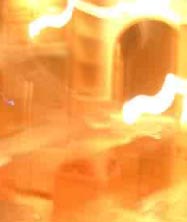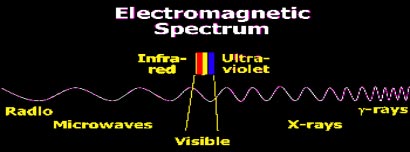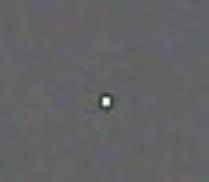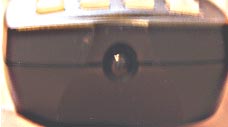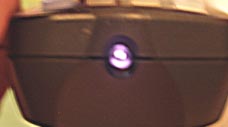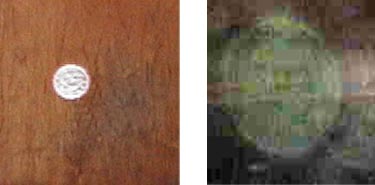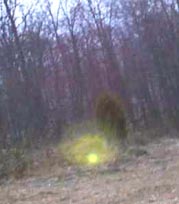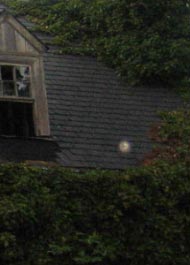|
[an error occurred while processing this directive]
|
November 9, 2006
Ghost Photography: OrbsBy Robbin Van Pelt, Professional Photographer/Paranormal InvestigatorOrbs: Naturalistic, Paranormal, or Man-Made Not all orbs are ghosts; a majority of them are actually due to other causes. There are many man-made and natural causes that can cause orbs to appear in photographs. The following is a compilation of my 26 years of technical training in photography and 22 years of paranormal research and investigation. I also found several Web sites with accurate information that I believe very useful to the reader so their information is also included in this article. Orbs is the name given to round (circular) anomalies that keep appearing in photographs. In photography and videography, orbs appear to be balls of light, diamonds, or smears of light with an apparent size in the image ranging from that of a nail's head to a golf ball. Orbs can sometimes appear to be in motion, have a trail, or a ribbon-like appearance. Most orbs seem to be transparent and either very pale blue or white. I have seen others that appear to glow in yellow, red, and/or blue. There seems to be three main opinions regarding the cause of orbs in photographs. The naturalistic opinion holds that orbs are a clear-cut case of flash reflection off of dust particles, insects, or moisture droplets in the air in front of the camera -- meaning they are naturally occurring. An example of airborne particles would be dust floating into a beam of light -- think of opening a heavy curtain inside of a dark room. Dust can also show up in photographs as orbs, especially when dust is close to the lens and most especially with digital cameras. The opposing opinion maintains that orbs are paranormal in nature (i.e. non-naturalistic). An orb is believed to be the soul of a once-living person or animal, or the energy particles of a spirit. The last view is what we call man-made. These photos are generally images that have been manipulated by computers or people trying to fake a ghost photo. Other causes are reflections from objects such as mirrors, wood, glass, and crystals that people have hanging around. When using photo paper and negatives, sometimes there are developing and printing flaws. Film can have water droplets or chemical spots. The paper itself can have damage or scratches that were not seen until development and appear as streaks of color in your photos. Ghost investigators who post orb photographs on their Web sites often post those that are man-made or natural. Very few sites actually show real orbs because real orbs (yes there are real ones) are few and far between. While investigators claim that orbs are more likely to appear in haunted locations or are attracted to certain humans, the majority of images on the Internet that are devoted to orbs are taken in backyards, attics, kitchens, and bars -- basically anywhere people are taking photos. Since orb photos seem to be obtained anywhere, the position of paranormal investigators who claim orb photos are more common in allegedly haunted areas is significantly weakened. Orb photos have become so common that some organizations are no longer accepting them. The organization that I represent, The Maryland Paranormal Investigators Coalition, no longer accepts them, except in rare circumstances. I don't know about you, but I get frustrated watching the ghost shows on TV when they claim "look it's a ghost, the digital camera captured one and look at our video a white ball of light, an orb, just ran across the screen." These shows give the audience a false perception. The investigators are doing their jobs but Hollywood edits the programs to show what they want for the ratings, not for the facts, or proper use of equipment. There are photographic experts out there who can give you an expert opinion using their knowledge in photography, videography, lens optics, and the color spectrum. All of their information is based off of science and years and years of study. Does this mean that we are 100% right every time? No. We weren't there when the photo was taken and we don�t have access to your evidence data. There are no experts in this field no matter who claims to be one. It takes everyone in the paranormal research field to put together information that's collected on investigations and come up with a hypothesis. Any investigator can give you an opinion, but that is all you get -- "an opinion." However, there are very experienced and educated investigators out there who can point you in the right direction with answers that are researched, studied, and investigated (i.e. the right way). In order to tell the difference between paranormal and naturalistic orbs you also need to study the evidence surrounding them at the time the photograph was taken. Evidence such as: cold spots, EMF and Trifield readings, humidity and temperature readings, odors, touches, EVP, and the personal observations of the researchers. There are a number of natural causes for orbs in photography and videography which include:
Particles such as dust and water droplets can be lit up by the flash. These particles need to be within a few
centimeters of the camera lens, meaning very close in both proximity and plane as the camera lens axis. Since the air we breath is not particle free, it seems the chance of this
occurring is very high. Most buildings are inhabited by microscopic flying insects that we
can't see with our eyes but can be seen by the camera. They survive all year round, especially with central heating and air. Have you ever seen those little light balls on night vision video that seem to move rapidly and
sporadically? In the experiments that I have conducted, I have found water droplets to be more reflective than dust particles.
Orbs of a rectangular or octagonal shape are caused because an object with a shape similar to the aperture (the aperture is the hole that opens to let light through the lens)
of the camera lens is out-of-focus (beyond depth of field range). The object will begin to take the shape of the aperture.
Naturalistic/Man-Made Ways Angle of Reflection In the diagram above, the ray of light approaching the mirror is known as the incident ray (labeled I in the diagram). The ray of light, which leaves the mirror, is known as the reflected ray (labeled R in the diagram). At the point of incidence where the ray strikes the mirror, a line can be drawn perpendicular to the surface of the mirror; this line is known as a normal line (labeled N in the diagram). The normal line divides the angle between the incident ray and the reflected ray into two equal angles. The angle between the incident ray and the normal is known as the angle of incidence. The angle between the reflected ray and the normal is known as the angle of reflection. Diffuse Reflection When light strikes a rough or granular surface, it bounces off in all directions due to the microscopic irregularities. Thus, an image is not formed. This is called diffuse reflection. The exact form of the reflection depends on the structure of the surface. Diffuse interreflection is a process whereby light reflected from an object strikes other objects in the surrounding area, illuminating them. Diffuse interreflection specifically describes light reflected from objects, which are not shiny or specular. Lens Flare Another phenomena that is often mistaken for something paranormal is called "lens flare" which occurs when a bright light source (most often the sun) reflects off a portion of the lens and creates internal reflections of the aperture of the camera. Generally flare can be ruled out of most photos taken at night, but can be a problem with shooting pictures during the day. Slow Shutter Speed I cannot tell you how many photos I have seen from people who say,
"Look, it's paranormal -- the ghost caused it to
blur." No, the ghosts did not do it. It's called a slow shutter speed. The amount of light reaching the film or CCD is known as the exposure and this is controlled by two items on a camera
-- the aperture and shutter speed.
Light entering the eye is absorbed by light-sensitive pigments within the rod cells and cone cells in the retina, which creates electrochemical nerve pulses that travel through the optic nerve to the brain, producing what we call vision.
Our eyes have light sensors that are sensitive to the visible
spectrum's wavelengths. When light waves strike these sensors, the sensors send signals to the brain. These signals are often perceived by the brain as a particular color. Exactly which color is seen depends on the composition of wavelengths in the light waves. For example, if the sensors detect all visible wavelengths at once, the brain perceives white light. If no wavelengths are detected, there is no light present and the brain perceives black.
Some animals, such as bees, can see UV radiation while others, such as snakes, can see infrared light.
Testing your camera
Non-Naturalistic
Another view of spirit orbs holds that they are non-human spirits, with blue and red orbs symbolizing angels and the devil respectively. Another interpretation of colors in orbs is sex differentiation
-- blue for male spirits, and red or pink for female, or that they indicate what mood the spirit is in. If orbs are energy they should be emitting light. Spirit orbs are also felt by some to be curious friendly protectors, particularly of children.
Even those "true believers" who steadfastly maintain that orbs are of paranormal origin are often forced to concede that dust may be the cause of most orb photos. A subset of these believers say that they can tell the difference between "dust orbs" and "real" (spirit) orbs, sometimes from a close examination of the image, or because of how they felt or were acting at the moment the photo was taken. Some true believers say that the orbs respond to spoken requests to appear, move, or appear as different colors.
Whatever your belief is when it comes to orb photos, things may not always be what they seem. Just keep in mind to look carefully at what you see and look around you, be more aware of your surroundings when taking a photo. Look for reflective things,
don't just point and shoot, as I have seen many people do. I hope some of this information is helpful when trying to decide for yourself what is in your pictures.
Robbin Van Pelt graduated from Cecil Community College in 1986 as a Professional Photographic Laboratory Technician with a background in criminal justice, computer repair, electronics, digital imaging, and video work. She also has a certification, as a Web Graphics Designer from Harford Community College She has been involved with the paranormal since 1984. She worked for many years as a photographer for the Department of Defense.
Robbin is the founder of United States Ghosts Chasers; she is Director of Operations and Photo/Video Analyst for The Maryland Paranormal Investigators Coalition. She is Vice-President of Baltimore County Paranormal Research. Robbin uses her skills to help The Baltimore Society of Paranormal Research, Southern Ghost, and The New Jersey Ghost Hunters Society. She has investigated with Mark Nesbitt of "The Ghost of Gettysburg" fame, Troy Taylor the author of The Ghost Hunters Guide Book and 20 other ghost books, and Rosemary Ellen Guily author of The Encyclopedia of Ghost and Spirits and 30 other books on the supernatural. Robbin was published in her 1st book written by Lynda Lee Macken called Haunted Baltimore. She is also in Ed Okonowicz's book, Baltimore Ghost and Vince Wilson's Ghost Tech and Ghost Science. She was in the October 2004 issue of Baltimore Magazine. Robbin has also appeared on the local major TV stations in Baltimore and in local papers, The Beltsville News, Capital News online and What�s Happening Baltimore Oct. 2005, FATE magazine, the TV show Creepy Canada in 2005 at the USS Constellation and Edgar Allan Poe�s Grave at the Westminster Catacombs. Robbin also filmed an episode for The Discovery Channel in 2006 at the Edgar Allan Poe House in Baltimore and is working on writing her own book called Havre De Grace Hauntings and Legends. Informational References: Cool Cosmos Parascience: http://www.parascience.org.uk/misc/method/orbs.htm Wikipedia: http://en.wikipedia.org/wiki/Orb_(paranormal) The Physics Classroom: http://www.glenbrook.k12.il.us/gbssci/phys/Class/refln/u13l1c.html Dr. Bruce Maccabee: http://brumac.8k.com/orb2.html NDT Resource Center Kodak: http://www.kodak.com
| | ||||||



